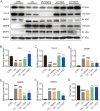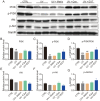Ergothioneine Protects Against UV-Induced Oxidative Stress Through the PI3K/AKT/Nrf2 Signaling Pathway
- PMID: 38854850
- PMCID: PMC11162207
- DOI: 10.2147/CCID.S449987
Ergothioneine Protects Against UV-Induced Oxidative Stress Through the PI3K/AKT/Nrf2 Signaling Pathway
Abstract
Background: Ergothioneine (EGT) is an antioxidant, which could be detected in human tissues, and human skin cells could utilize EGT and play an anti-oxidative role in keratinocytes. And in this study we are going to elucidate whether EGT could protect the skin from photoaging by Ultraviolet (UV) exposure in mice and its molecule pathway.
Methods: Histological analysis was performed for evaluating the skin structure change. Malondialdehyde (MDA) and superoxide dismutase (SOD) levels were measured with biological assay for evaluating oxidative and antioxidative ability of skin exposed to UV light. And the level of marker molecules in mouse skin were detected by hydroxyproline (Hyp) assay, immunohistochemical analysis, Western blot, and quantitative real-time PCR (qRT-PCR). The markers of skin aging and cell death were tested by cell culture and treatment, Western blot and qRT-PCR.
Results: EGT decreased the levels of inflammatory factors induced by UV exposure in mouse skin. MDA and SOD activity detection showed that EGT decreased MDA levels, increased SOD activity, and upregulated PI3K/Akt/Nrf2 signals in mouse skin exposed to UV, which further activated Nrf2 in the nucleus and enhanced the expression of Nrf2 target genes. In the cell model, we revealed that EGT could inhibit the increase in senescence-associated β-galactosidase-positive cells and p16 and γ-H2A.X positive cells induced by etoposide and activate PI3K/Akt/Nrf2 signaling. Moreover, a PI3K inhibitor blocked EGT protection against etoposide-induced cell death.
Conclusion: The study showed EGT may play an important protective role against cell damage or death through the PI3K/Akt/Nrf2 signaling pathway in skin.
Keywords: Nrf2; PI3K/Akt; ergothioneine; skin aging.
© 2024 Li et al.
Conflict of interest statement
Ergothioneine production patent (WO-2014100752-A1) has been assigned from Boston University to Ergo-health LLC and Pinghua Liu is one of the co-founders of Ergo-health. The authors declare that they have no other competing interests in this work.
Figures







Similar articles
-
Dermato-protective properties of ergothioneine through induction of Nrf2/ARE-mediated antioxidant genes in UVA-irradiated Human keratinocytes.Free Radic Biol Med. 2015 Sep;86:102-17. doi: 10.1016/j.freeradbiomed.2015.05.026. Epub 2015 May 27. Free Radic Biol Med. 2015. PMID: 26021820
-
Ergothioneine alleviates senescence of fibroblasts induced by UVB damage of keratinocytes via activation of the Nrf2/HO-1 pathway and HSP70 in keratinocytes.Exp Cell Res. 2021 Mar 1;400(1):112516. doi: 10.1016/j.yexcr.2021.112516. Epub 2021 Feb 9. Exp Cell Res. 2021. PMID: 33577831
-
The Antiaging Activity of Ergothioneine in UVA-Irradiated Human Dermal Fibroblasts via the Inhibition of the AP-1 Pathway and the Activation of Nrf2-Mediated Antioxidant Genes.Oxid Med Cell Longev. 2020 Feb 12;2020:2576823. doi: 10.1155/2020/2576823. eCollection 2020. Oxid Med Cell Longev. 2020. PMID: 32104530 Free PMC article.
-
Nrf2 Overexpression for the Protective Effect of Skin-Derived Precursors against UV-Induced Damage: Evidence from a Three-Dimensional Skin Model.Oxid Med Cell Longev. 2019 Oct 14;2019:7021428. doi: 10.1155/2019/7021428. eCollection 2019. Oxid Med Cell Longev. 2019. PMID: 31737172 Free PMC article.
-
Modified Qing'e Formula protects against UV-induced skin oxidative damage via the activation of Nrf2/ARE defensive pathway.Front Pharmacol. 2022 Oct 28;13:976473. doi: 10.3389/fphar.2022.976473. eCollection 2022. Front Pharmacol. 2022. PMID: 36386207 Free PMC article.
Cited by
-
Dysregulation of autophagy during photoaging reduce oxidative stress and inflammatory damage caused by UV.Front Pharmacol. 2025 May 12;16:1562845. doi: 10.3389/fphar.2025.1562845. eCollection 2025. Front Pharmacol. 2025. PMID: 40421222 Free PMC article. Review.
-
Biochemical Mechanism of Thai Fermented Soybean Extract on UVB-Induced Skin Keratinocyte Damage and Inflammation.Int J Mol Sci. 2025 Apr 5;26(7):3418. doi: 10.3390/ijms26073418. Int J Mol Sci. 2025. PMID: 40244292 Free PMC article.
References
-
- Hartman PE. Ergothioneine as antioxidant. Methods Enzymol. 1990;186:310. - PubMed
-
- Hseu YC, Vudhya Gowrisankar Y, Chen XZ, Yang YC, Yang HL. The antiaging activity of ergothioneine in UVA-irradiated human dermal fibroblasts via the inhibition of the AP-1 pathway and the activation of Nrf2-mediated antioxidant genes. Oxid Med Cell Longev. 2020;2020(10):2576823. doi:10.1155/2020/2576823 - DOI - PMC - PubMed
LinkOut - more resources
Full Text Sources

